15.7E: Ejercicios para la Sección 15.7
- Page ID
- 116282
En los ejercicios 1 - 6, se da la función\(T : S \rightarrow R, \space T (u,v) = (x,y)\) sobre la región\(S = \big\{(u,v) \,|\, 0 \leq u \leq 1, \space 0 \leq v \leq 1\big\}\) delimitada por la unidad cuadrada, donde\(R \in R^2\) está la imagen de\(S\) debajo\(T\).
a. Justificar que la función\(T\) es una\(C^1\) transformación.
b. Encuentra las imágenes de los vértices de la unidad cuadrada\(S\) a través de la función\(T\).
c. Determinar la imagen\(R\) de la unidad cuadrada\(S\) y graficarla.
1. \(x = 2u, \space y = 3v\)
2. \(x = \frac{u}{2}, \space y = \frac{v}{3}\)
- Contestar
-
a.\(T(u,v) = (g(u,v), \space h(u,v), \space x = g(u,v) = \frac{u}{2}\) y\(y = h(u,v) = \frac{v}{3}\). Las funciones\(g\) y\(h\) son continuas y diferenciables, y las derivadas parciales\(g_u (u,v) = \frac{1}{2}, \space g_v (u,v) = 0, \space h_u (u,v) = 0\) y\(h_v (u,v) = \frac{1}{3}\) son continuas\(S\);
b.\(T(0,0) = (0,0), \space T(1,0) = \left(\frac{1}{2},0\right), \space T(0,1) = \left(0,\frac{1}{3}\right)\), y\(T(1,1) = \left(\frac{1}{2}, \frac{1}{3} \right)\);
c.\(R\) es el rectángulo de vértices\((0,0), \space \left(0,\frac{1}{3}\right), \space \left(\frac{1}{2}, \frac{1}{3} \right)\), y\(\left(0,\frac{1}{3}\right)\) en el\(xy\) plano -plano; la siguiente figura.
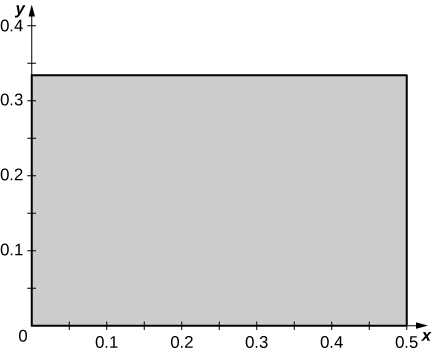
3. \(x = u - v, \space y = u + v\)
4. \(x = 2u - v, \space y = u + 2v\)
- Answer
-
a. \(T(u,v) = (g(u,v), \space h(u,v), \space x = g(u,v) = 2u - v\) and \(y = h(u,v) = u + 2v\). The functions \(g\) and \(h\) are continuous and differentiable, and the partial derivatives \(g_u (u,v) = 2, \space g_v (u,v) = -1, \space h_u (u,v) = 1\) and \(h_v (u,v) = 2\) are continuous on \(S\);
b. \(T(0,0) = (0,0), \space T(1,0) = (2,1), \space T(0,1) = (-1,2)\), and \(T(1,1) = (1,3)\);
c. \(R\) is the parallelogram of vertices \((0,0), \space (2,1) \space (1,3)\), and \((-1,2)\) in the \(xy\)-plane; the following figure.
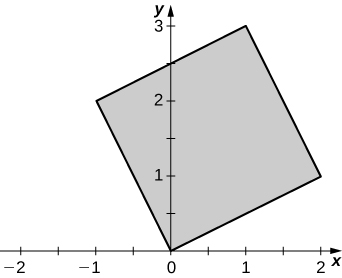
5. \(x = u^2, \space y = v^2\)
6. \(x = u^3, \space y = v^3\)
- Contestar
-
a.\(T(u,v) = (g(u,v), \space h(u,v), \space x = g(u,v) = u^3\) y\(y = h(u,v) = v^3\). Las funciones\(g\) y\(h\) son continuas y diferenciables, y las derivadas parciales\(g_u (u,v) = 3u^2, \space g_v (u,v) = 0, \space h_u (u,v) = 0\) y\(h_v (u,v) = 3v^2\) son continuas\(S\);
b.\(T(0,0) = (0,0), \space T(1,0) = (1,0), \space T(0,1) = (0,1)\), y\(T(1,1) = (1,1)\);
c.\(R\) es la unidad cuadrada en el\(xy\) plano -ver la figura en la respuesta al ejercicio anterior.
En los ejercicios 7 - 12, determinar si las transformaciones\(T : S \rightarrow R\) son uno a uno o no.
7. \(x = u^2, \space y = v^2\), donde\(S\) está el rectángulo de vértices\((-1,0), \space (1,0), \space (1,1)\), y\((-1,1)\).
8. \(x = u^4, \space y = u^2 + v\), donde\(S\) está el triángulo de vértices\((-2,0), \space (2,0)\), y\((0,2)\).
- Contestar
- \(T\)no es uno a uno: dos puntos de\(S\) tienen la misma imagen. Efectivamente,\(T(-2,0) = T(2,0) = (16,4)\).
9. \(x = 2u, \space y = 3v\), donde\(S\) está el cuadrado de vértices\((-1,1), \space (-1,-1), \space (1,-1)\), y\((1,1)\).
10. \(T(u, v) = (2u - v, u),\)donde\(S\) está el triángulo con vértices\((-1,1), \, (-1,-1)\), y\((1,-1)\).
- Contestar
- \(T\)es uno a uno: Argumentamos por contradicción. \(T(u_1,v_1) = T(u_2,v_2)\)implica\(2u_1 - v_1 = 2u_2 - v_2\) y\(u_1 = u_2\). Así,\(u_1 = u+2\) y\(v_1 = v_2\).
11. \(x = u + v + w, \space y = u + v, \space z = w\), donde\(S = R = R^3\).
12. \(x = u^2 + v + w, \space y = u^2 + v, \space z = w\), donde\(S = R = R^3\).
- Contestar
- \(T\)no es uno a uno:\(T(1,v,w) = (-1,v,w)\)
En los ejercicios 13 - 18, las transformaciones\(T : R \rightarrow S\) son uno a uno. Encuentra sus transformaciones inversas relacionadas\(T^{-1} : R \rightarrow S\).
13. \(x = 4u, \space y = 5v\), donde\(S = R = R^2\).
14. \(x = u + 2v, \space y = -u + v\), donde\(S = R = R^2\).
- Contestar
- \(u = \frac{x-2y}{3}, \space v= \frac{x+y}{3}\)
15. \(x = e^{2u+v}, \space y = e^{u-v}\), donde\(S = R^2\) y\(R = \big\{(x,y) \,|\, x > 0, \space y > 0\big\}\)
16. \(x = \ln u, \space y = \ln(uv)\), donde\(S = \big\{(u,v) \,|\, u > 0, \space v > 0\big\}\) y\(R = R^2\).
- Contestar
- \(u = e^x, \space v = e^{-x+y}\)
17. \(x = u + v + w, \space y = 3v, \space z = 2w\), donde\(S = R = R^3\).
18. \(x = u + v, \space y = v + w, \space z = u + w\), donde\(S = R = R^3\).
- Contestar
- \(u = \frac{x-y+z}{2}, \space v = \frac{x+y-z}{2}, \space w = \frac{-x+y+z}{2}\)
En los ejercicios 19 - 22 se da la transformación\(T : S \rightarrow R, \space T (u,v) = (x,y)\) y la región\(R \subset R^2\). Encuentra la región\(S \subset R^2\).
19. \(x = au, \space y = bv, \space R = \big\{(x,y) \,|\, x^2 + y^2 \leq a^2 b^2\big\}\)donde\(a,b > 0\)
20. \(x = au, \space y = bc, \space R = \big\{(x,y) \,|\, \frac{x^2}{a^2} + \frac{y^2}{b^2} \leq 1\big\}\), donde\(a,b > 0\)
- Contestar
- \(S = \big\{(u,v) \,|\, u^2 + v^2 \leq 1\big\}\)
21. \(x = \frac{u}{a}, \space y = \frac{v}{b}, \space z = \frac{w}{c}, \space R = \big\{(x,y)\,|\,x^2 + y^2 + z^2 \leq 1\big\}\), donde\(a,b,c > 0\)
22. \(x = au, \space y = bv, \space z = cw, \space R = \big\{(x,y)\,|\,\frac{x^2}{a^2} - \frac{y^2}{b^2} - \frac{z^2}{c^2} \leq 1, \space z > 0\big\}\), donde\(a,b,c > 0\)
- Contestar
- \(R = \big\{(u,v,w)\,|\,u^2 - v^2 - w^2 \leq 1, \space w > 0\big\}\)
En los ejercicios 23 - 32, encuentra al jacobiano\(J\) de la transformación.
23. \(x = u + 2v, \space y = -u + v\)
24. \(x = \frac{u^3}{2}, \space y = \frac{v}{u^2}\)
- Contestar
- \(\frac{3}{2}\)
25. \(x = e^{2u-v}, \space y = e^{u+v}\)
26. \(x = ue^v, \space y = e^{-v}\)
- Contestar
- \(-1\)
27. \(x = u \space \cos (e^v), \space y = u \space \sin(e^v)\)
28. \(x = v \space \sin (u^2), \space y = v \space \cos(u^2)\)
- Contestar
- \(2uv\)
29. \(x = u \space \cosh v, \space y = u \space \sinh v, \space z = w\)
30. \(x = v \space \cosh \left(\frac{1}{u}\right), \space y = v \space \sinh \left(\frac{1}{u}\right), \space z = u + w^2\)
- Contestar
- \(\frac{v}{u^2}\)
31. \(x = u + v, \space y = v + w, \space z = u\)
32. \(x = u - v, \space y = u + v, \space z = u + v + w\)
- Contestar
- \(2\)
33. La región triangular\(R\) con los vértices\((0,0), \space (1,1)\), y\((1,2)\) se muestra en la siguiente figura.
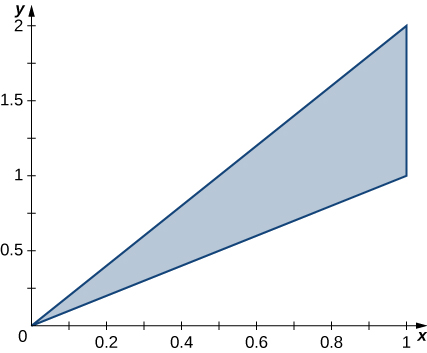
a. Encontrar una transformación\(T : S \rightarrow R, \space T(u,v) = (x,y) = (au + bv + dv)\), where \(a,b,c\), and \(d\) are real numbers with \(ad - bc \neq 0\) such that \(T^{-1} (0,0) = (0,0), \space T^{-1} (1,1) = (1,0)\), and \(T^{-1}(1,2) = (0,1)\).
b. Use the transformation \(T\) to find the area \(A(R)\) of the region \(R\).
34. The triangular region \(R\) with the vertices \((0,0), \space (2,0)\), and \((1,3)\) is shown in the following figure.

a. encontrar una transformación\(T : S \rightarrow R, \space T(u,v) = (x,y) = (au + bv + dv)\), donde\(a,b,c\), y\(d\) son números reales con\(ad - bc \neq 0\) tal que\(T^{-1} (0,0) = (0,0), \space T^{-1} (2,0) = (1,0)\), y\(T^{-1}(1,3) = (0,1)\).
b. Utilizar la transformación\(T\) para encontrar el área\(A(R)\) de la región\(R\).
- Contestar
-
a.\(T (u,v) = (2u + v, \space 3v)\)
b. El área de\(R\) es\(\displaystyle A(R) = \int_0^3 \int_{y/3}^{(6-y)/3} \, dx \, dy = \int_0^1 \int_0^{1-u} \left|\frac{\partial (x,y)}{\partial (u,v)}\right| \, dv \space du = \int_0^1 \int_0^{1-u} 6 \, dv \, du = 3.\)
En los ejercicios 35 - 36, utilice la transformación\(u = y - x, \space v = y\), para evaluar las integrales en el paralelogramo\(R\) de vértices\((0,0), \space (1,0), \space (2,1)\), y\((1,1)\) se muestra en la siguiente figura.
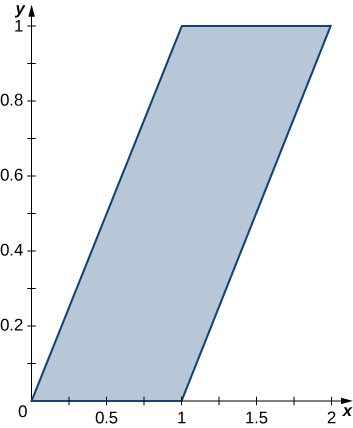
35. \(\displaystyle \iint_R (y - x) \, dA\)
36. \(\displaystyle \iint_R (y^2 - xy) \, dA\)
- Answer
- \(-\frac{1}{4}\)
In exercises 37 - 38, use the transformation \(y = x = u, \space x + y = v\) to evaluate the integrals on the square \(R\) determined by the lines \(y = x, \space y = -x + 2, \space y = x + 2\), and \(y = -x\) shown in the following figure.
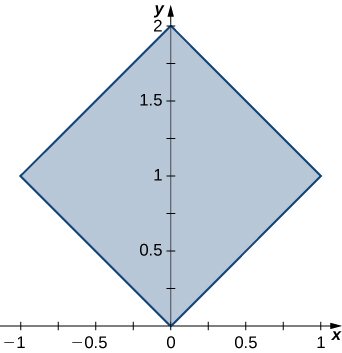
37. \(\displaystyle \iint_R e^{x+y} \, dA\)
38. \(\displaystyle \iint_R \sin (x - y) \, dA\)
- Contestar
- \(-1 + \cos 2\)
En los ejercicios 39 - 40, utilice la transformación\(x = u, \space 5y = v\) para evaluar las integrales en la región\(R\) delimitada por la elipse\(x^2 + 25y^2 = 1\) mostrada en la siguiente figura.

39. \(\displaystyle \iint_R \sqrt{x^2 + 25y^2} \, dA\)
40. \(\displaystyle \iint_R (x^2 + 25y^2)^2 \, dA\)
- Answer
- \(\frac{\pi}{15}\)
In exercises 41 - 42, use the transformation \(u = x + y, \space v = x - y\) to evaluate the integrals on the trapezoidal region \(R\) determined by the points \((1,0), \space (2,0), \space (0,2)\), and \((0,1)\) shown in the following figure.
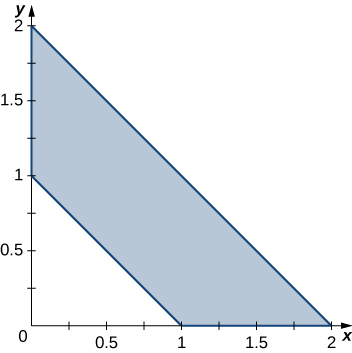
41. \(\displaystyle \iint_R (x^2 - 2xy + y^2) \space e^{x+y} \, dA\)
42. \(\displaystyle \iint_R (x^3 + 3x^2y + 3xy^2 + y^3) \, dA\)
- Contestar
- \(\frac{31}{5}\)
43. El sector anular circular\(R\) delimitado por los círculos\(4x^2 + 4y^2 = 1\) y\(9x^2 + 9y^2 = 64\), la línea\(x = y \sqrt{3}\), y el\(y\) eje -se muestra en la siguiente figura. Encuentre una transformación\(T\) de una región rectangular\(S\) en el\(r\theta\) plano -a la región\(R\) en el\(xy\) plano. Gráfica\(S\).
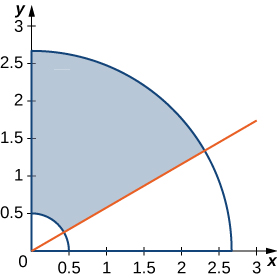
44. El sólido\(R\) bounded by the circular cylinder \(x^2 + y^2 = 9\) and the planes \(z = 0, \space z = 1, \space x = 0\), and \(y = 0\) is shown in the following figure. Find a transformation \(T\) from a cylindrical box \(S\) in \(r\theta z\)-space to the solid \(R\) in \(xyz\)-space.
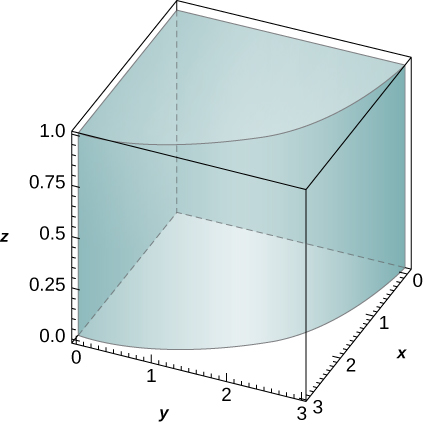
- Contestar
- \(T (r,\theta,z) = (r \space \cos \theta, \space r \space \sin \theta, \space z); \space S = [0,3] \times [0,\frac{\pi}{2}] \times [0,1]\)en el\(r\theta z\) -espacio
45. Mostrar que\[\iint_R f \left(\sqrt{\frac{x^2}{3} + \frac{y^2}{3}}\right) dA = 2 \pi \sqrt{15} \int_0^1 f (\rho) \rho \space d\rho, \nonumber \] donde\(f\) es una función continua\([0,1]\) y\(R\) es la región delimitada por la elipse\(5x^2 + 3y^2 = 15\).
46. Mostrar que\[\iiint_R f \left(\sqrt{16x^2 + 4y^2 + z^2}\right) dV = \frac{\pi}{2} \int_0^1 f (\rho) \rho^2 d\rho, \nonumber \] donde\(f\) es una función continua\([0,1]\) y\(R\) es la región delimitada por el elipsoide\(16x^2 + 4y^2 + z^2 = 1\).
47. [T] Encontrar el área de la región delimitada por las curvas\(xy = 1, \space xy = 3, \space y = 2x\), y\(y = 3x\) mediante el uso de la transformación\(u = xy\) y\(v = \frac{y}{x}\). Utilice un sistema de álgebra por computadora (CAS) para graficar las curvas de contorno de la región\(R\).
48. [T] Encontrar el área de la región delimitada por las curvas\(x^2y = 2, \space x^2y = 3, \space y = x\), y\(y = 2x\) mediante el uso de la transformación\(u = x^2y\) y\(v = \frac{y}{x}\). Utilice un CAS para graficar las curvas de contorno de la región\(R\).
- Contestar
-
El área de\(R\) es\(10 - 4\sqrt{6}\); las curvas de límite de\(R\) están graficadas en la siguiente figura.
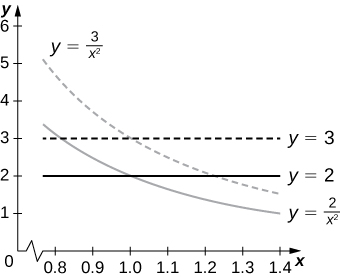
49. Evaluar la triple integral\[\int_0^1 \int_1^2 \int_z^{z+1} (y + 1) \space dx \space dy \space dz \nonumber \] by using the transformation \(u = x - z, \space v = 3y\), and \(w = \frac{z}{2}\).
50. Evaluate the triple integral \[\int_0^2 \int_4^6 \int_{3z}^{3z+2} (5 - 4y) \space dx \space dy \space dz \nonumber \] by using the transformation \(u = x - 3z, \space v = 4y\), and \(w = z\).
- Answer
- \(8\)
51. A transformation \(T : R^2 \rightarrow R^2, \space T (u,v) = (x,y)\) of the form \(x = au + bv, \space y = cu + dv\), where \(a,b,c\), and \(d\) are real numbers, is called linear. Show that a linear transformation for which \(ad - bc \neq 0\) maps parallelograms to parallelograms.
52. A transformation \(T_{\theta} : R^2 \rightarrow R^2, \space T_{\theta} (u,v) = (x,y)\) of the form \(x = u \space \cos \theta - v \space \sin \theta, \space y = u \space \sin \theta + v \space \cos \theta\), is called a rotation angle \(\theta\). Show that the inverse transformation of \(T_{\theta}\) satisfies \(T_{\theta}^{-1} = T_{-\theta}\) where \(T_{-\theta}\) is the rotation of angle \(-\theta\).
53. [T] Find the region \(S\) in the \(uv\)-plane whose image through a rotation of angle \(\frac{\pi}{4}\) is the region \(R\) enclosed by the ellipse \(x^2 + 4y^2 = 1\). Use a CAS to answer the following questions.
a. Graph the region \(S\).
b. Evaluate the integral \(\displaystyle \iint_S e^{-2uv} \, du \, dv.\) Round your answer to two decimal places.
54. [T] The transformations \(T_i : \mathbb{R}^2 \rightarrow \mathbb{R}^2, \space i = 1, . . . , 4,\) defined by \(T_1(u,v) = (u,-v), \space T_2 (u,v) = (-u,v), \space T_3 (u,v) = (-u, -v)\), and \(T_4 (u,v) = (v,u)\) are called reflections about the \(x\)-axis, \(y\)-axis origin, and the line \(y = x\), respectively.
a. Find the image of the region \(S = \big\{(u,v)\,|\,u^2 + v^2 - 2u - 4v + 1 \leq 0\big\}\) in the \(xy\)-plane through the transformation \(T_1 \circ T_2 \circ T_3 \circ T_4\).
b. Use a CAS to graph \(R\).
c. Evaluate the integral \(\displaystyle \iint_S \sin (u^2) \, du \, dv\) by using a CAS. Round your answer to two decimal places.
- Answer
-
a. \(R = \big\{(x,y)\,|\,y^2 + x^2 - 2y - 4x + 1 \leq 0\big\}\);
b. \(R\) is graphed in the following figure;
c.\(3.16\)
55. [T] Las transformaciones\(T_{k,1,1} : \mathbb{R}^3 \rightarrow \mathbb{R}^3, \space T_{k,1,1}(u,v,w) = (x,y,z)\) de la forma\(x = ku, \space y = v, \space z = w\), donde\(k \neq 1\) es un número real positivo, se llama estiramiento si\(k > 1\) y compresión si\(0 < k < 1\) en la\(x\) dirección -dirección. Utilice un CAS para evaluar la integral\(\displaystyle \iiint_S e^{-(4x^2+9y^2+25z^2)} \, dx \, dy \, dz\) en el sólido\(S = \big\{(x,y,z) \,|\, 4x^2 + 9y^2 + 25z^2 \leq 1\big\}\) considerando la compresión\(T_{2,3,5}(u,v,w) = (x,y,z)\) definida por\(x = \frac{u}{2}, \space y = \frac{v}{3}\), y\(z = \frac{w}{5}\). Redondee su respuesta a cuatro decimales.
56. [T] La transformación\(T_{a,0} : \mathbb{R}^2 \rightarrow \mathbb{R}^2, \space T_{a,0} (u,v) = (u + av, v)\), donde\(a \neq 0\) es un número real, se llama cizallamiento en la\(x\) dirección -dirección. La transformación\(T_{b,0} : R^2 \rightarrow R^2, \space T_{o,b}(u,v) = (u,bu + v)\), donde\(b \neq 0\) es un número real, se llama cizallamiento en la\(y\) dirección -dirección.
a. Encontrar transformaciones\(T_{0,2} \circ T_{3,0}\).
b. Encontrar la imagen\(R\) de la región trapezoidal\(S\) delimitada por\(u = 0, \space v = 0, \space v = 1\), y\(v = 2 - u\) a través de la transformación\(T_{0,2} \circ T_{3,0}\).
c. Utilice un CAS para graficar la imagen\(R\) en el\(xy\) plano.
d. Encontrar el área de la región\(R\) utilizando el área de la región\(S\).
- Contestar
-
a.\(T_{0,2} \circ T_{3,0}(u,v) = (u + 3v, 2u + 7v)\);
b. La imagen\(S\) es el cuadrilátero de vértices\((0,0), \space (3,7), \space (2,4)\), y\((4,9)\);
c.\(S\) se grafica en la siguiente figura;
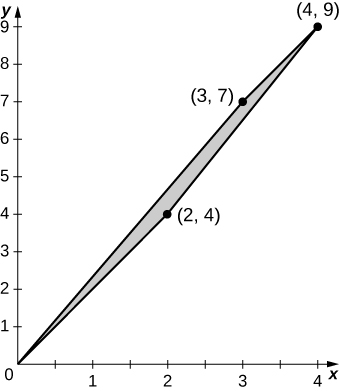
d.

